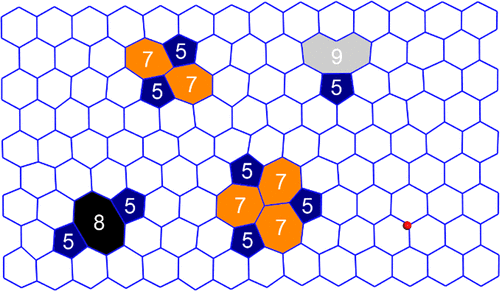当前位置:
X-MOL 学术
›
Chem. Mater.
›
论文详情
Our official English website, www.x-mol.net, welcomes your feedback! (Note: you will need to create a separate account there.)
Point Defects in Blue Phosphorene
Chemistry of Materials ( IF 7.2 ) Pub Date : 2019-09-19 , DOI: 10.1021/acs.chemmater.9b02871 Minglei Sun 1 , Jyh-Pin Chou 2 , Alice Hu 2 , Udo Schwingenschlögl 1
Chemistry of Materials ( IF 7.2 ) Pub Date : 2019-09-19 , DOI: 10.1021/acs.chemmater.9b02871 Minglei Sun 1 , Jyh-Pin Chou 2 , Alice Hu 2 , Udo Schwingenschlögl 1
Affiliation

|
Using first-principles calculations, we investigate selected defects in blue phosphorene (BlueP). For a single-vacancy (SV) defect, a 5–9 structure is energetically favorable, and for a double-vacancy defect, a 5–8–5 or 555–777 structure is. A P adatom favors the top adsorption site. Scanning tunneling microscopy images are simulated to aid the experimental identification of the defects. Formation of a Stone–Wales defect is found to be most likely, but it can be reverted by thermal annealing. Calculated migration and transformation barriers show that a SV defect can migrate easily. Both a SV defect and a P adatom induce a magnetic moment, thus turning BlueP into a magnetic semiconductor. It turns out that all of the defects under investigation enhance the ability of BlueP to absorb sunlight.
中文翻译:

蓝色磷的点缺陷
使用第一性原理计算,我们研究了蓝色磷(BlueP)中的选定缺陷。对于单空位(SV)缺陷,在能量上有利于5–9结构,而对于双空位缺陷,则在5–8–5或555–777结构上是有利的。AP吸附剂偏向顶部吸附位。模拟扫描隧道显微镜图像,以帮助对缺陷进行实验识别。人们发现最有可能形成Stone-Wales缺陷,但可以通过热退火将其恢复。计算得出的迁移和转化障碍表明,SV缺陷很容易迁移。SV缺陷和P原子都感应磁矩,从而将BlueP转变为磁性半导体。事实证明,所有正在研究的缺陷都增强了BlueP吸收阳光的能力。
更新日期:2019-09-19
中文翻译:

蓝色磷的点缺陷
使用第一性原理计算,我们研究了蓝色磷(BlueP)中的选定缺陷。对于单空位(SV)缺陷,在能量上有利于5–9结构,而对于双空位缺陷,则在5–8–5或555–777结构上是有利的。AP吸附剂偏向顶部吸附位。模拟扫描隧道显微镜图像,以帮助对缺陷进行实验识别。人们发现最有可能形成Stone-Wales缺陷,但可以通过热退火将其恢复。计算得出的迁移和转化障碍表明,SV缺陷很容易迁移。SV缺陷和P原子都感应磁矩,从而将BlueP转变为磁性半导体。事实证明,所有正在研究的缺陷都增强了BlueP吸收阳光的能力。











































 京公网安备 11010802027423号
京公网安备 11010802027423号